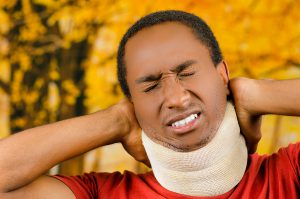The Basics Of Whiplash
 Michael Babboni
Car Accidents
Whiplash has been seen and joked about on so many shows and movies that most of us don’t see it as a serious injury. In fact, ‘whiplash’ is almost always used by a story’s ‘villain’ in order to falsely claim that they were injured by the ‘hero’. While this can be all laughs and jokes on film, it can cause a very misleading stereotype about the seriousness of whiplash.
Michael Babboni
Car Accidents
Whiplash has been seen and joked about on so many shows and movies that most of us don’t see it as a serious injury. In fact, ‘whiplash’ is almost always used by a story’s ‘villain’ in order to falsely claim that they were injured by the ‘hero’. While this can be all laughs and jokes on film, it can cause a very misleading stereotype about the seriousness of whiplash.What Is Whiplash?
Whiplash is a form of neck strain that results from a serious impact that roughly jerks the neck in a back and forth motion. While whiplash is often known as a common car accident injury, it can be caused in other traumatic accidents as well. Most forms of neck strain are from a pulled or strained muscle. However, whiplash is actually when the tendons, ligaments, and muscles within the neck have been torn. Additionally, whiplash can cause damage to the joints and spine as well.
Whiplash Symptoms
It is not uncommon for whiplash to be misdiagnosed so you need to understand a few of the immediate symptoms to expect from a whiplash injury. Within 24 hours of the accident, you may feel a few of the following symptoms:
- Stiffness in the neck
- Mild to severe neck pain
- Additional pain with neck movements
- Pain in the shoulder, arms or back
- Tingling or numbness in the arms
- Headaches
- Ringing in the ears
- Dizziness
- Blurred vision
- Difficulty concentrating
- Difficulty sleeping
Whiplash Side Effects
While the symptoms are rather uncomfortable on their own, they are not the only thing you have to worry about with a whiplash injury. Whiplash can bring along some dangerous side effects, especially when it has not been given immediate treatment. Some side effects for you to be on the lookout for include:
Cognitive dysfunction – With the neck being in close proximity to the head, it is not uncommon for whiplash to cause certain brain dysfunctions including headache, fatigue, forgetfulness and poor concentration.
Chronic pain – It is estimated that around 10 percent of whiplash patients will also experience chronic pain. While whiplash tends to heal rather quickly, some patients end up with permanent damage. In certain cases of chronic whiplash pain, patients will require surgery to ‘deaden’ the nerves to numb the pain.
Herniated discs in the spine – When there is a strain caused on the spine, like with whiplash injuries, it can create a tear along the discs between the vertebrae. The tears can end up causing the inner core of the disc to stick out. If this herniated disc happens to touch a nerve, it can cause rather severe pain and even lead to muscle numbness or weakness.
Faulty movement patterns – While the inability to move your neck is a rather normal symptom of whiplash, the damage of whiplash may further harm your body’s ability to move properly or to move without constant pain. This is especially true in incidences where the whiplash injury has also caused damage to the nerves or spine.
Treating Whiplash
While Hollywood enjoys to show ‘whiplash’ as an injury faked for extra money in court, this is a serious injury that really does need care and treatment to ensure your full recovery. Depending on how severe your whiplash is or the symptoms that present with it, your doctor may recommend one or more of the following treatments:
Painkillers – Typically, an over the counter anti-inflammatory painkiller should be all you need to ease the inflammation and pain associated with whiplash. However, your doctor may provide a prescription painkiller or muscle relaxer if your pain is severe enough.
Neck brace – Yes, you have seen this one in pretty much every single show and movie involving whiplash, but it really is an effective whiplash treatment. Since whiplash often causes pain with every neck movement, a neck brace helps to keep your head steady and avoid additional pain.
Hot And Cold Therapy – hot and cold therapy involves applying ice and heat to an injury during scheduled intervals. The ice will help to reduce any swelling the may be present and ease the pain. The heat, however, will help to promote blood flow and increase the rate of healing.
Chiropractic care – You may even find that your doctor recommends chiropractic care in order for a professional chiropractor to help reduce pain, improve your mobility, and promote healing.
